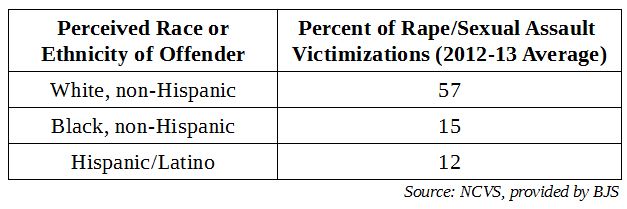Was Donald Trump Right About Rapists?
By this point there have been several attempts to fact-check Donald Trump's comment (and Amy Schumer's joke) about Hispanic rapists. But to my knowledge, none have presented some of the best data we have. The Justice Department's National Crime Victimization Survey asks Americans about their experiences with crime and collects data about the characteristics of violent offenders, including race and ethnicity. Unlike arrest or conviction data, it picks up many unreported crimes.
Unfortunately, these breakdowns are not published routinely, so they must be requested from the Bureau of Justice Statistics. I just received them:
For comparison, Hispanics are about 17 percent of the population, non-Hispanic blacks 12 percent, and non-Hispanic whites 63 percent. It seems that Donald Trump was wrong. In general, at least from these numbers, sexual-assault offending doesn't have a strong racial skew at all, and if anything Hispanic offenders are underrepresented.
Some assorted notes below my signature.
Robert VerBruggen is editor of RealClearPolicy. Twitter: @RAVerBruggen
Notes: A Politico story claimed to have this data, but the author mistakenly used numbers on victims instead of offenders. That piece has been corrected; a New York Times piece with the same numbers has not.
Victims who couldn't identify their attackers by race are excluded. 2012 and 2013 were averaged to give higher sample sizes, though BJS also gave me the years separately. (The survey reaches 160,000 people every year, but for rare crimes like sexual assault, broken down by race, this isn't always enough. In fact, even two years of data isn't enough to make the estimate for "other race, non-Hispanic" reliable, so I left it off.)
Further, BJS's cutoff for reliability is just ten cases, so even these estimates can vary a lot from year to year. From 2012 to 2013, the share of sex offenders who are white rose from 52 to 62 percent, while the black share rose from 13 to 17 -- and the unreliable "other" share fell all the way from 22 to 10. The survey didn't allow interviewees to identify attackers as Hispanic until 2012, so it's not possible to combine data for more years yet. (You can see 1995-2013 numbers for college-age victims, with more limited categories for offender races, here.)
Finally, as I also noted here, Hispanic is an ethnic rather than a racial category, so it overlaps with racial groupings— e.g., many Hispanics have a lot of Spanish or African ancestry, and thus might be perceived as white or black.





